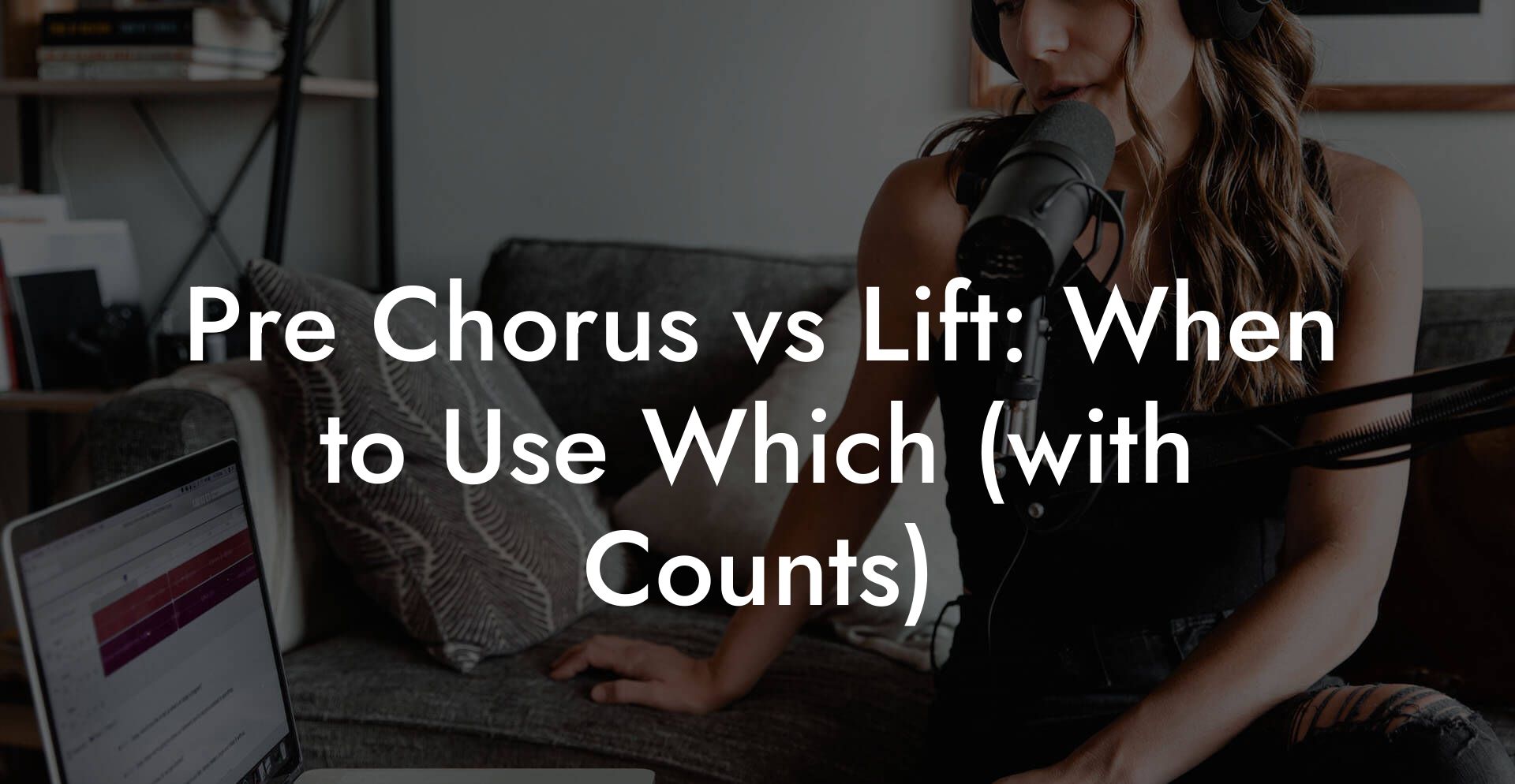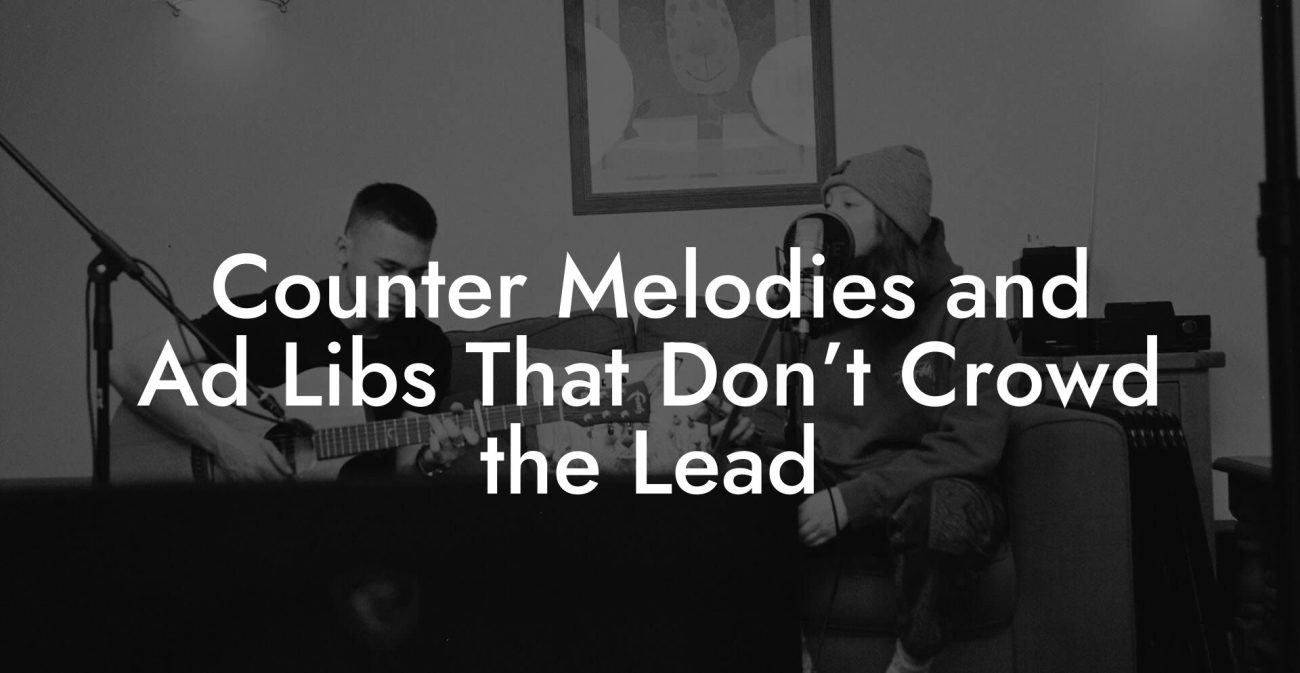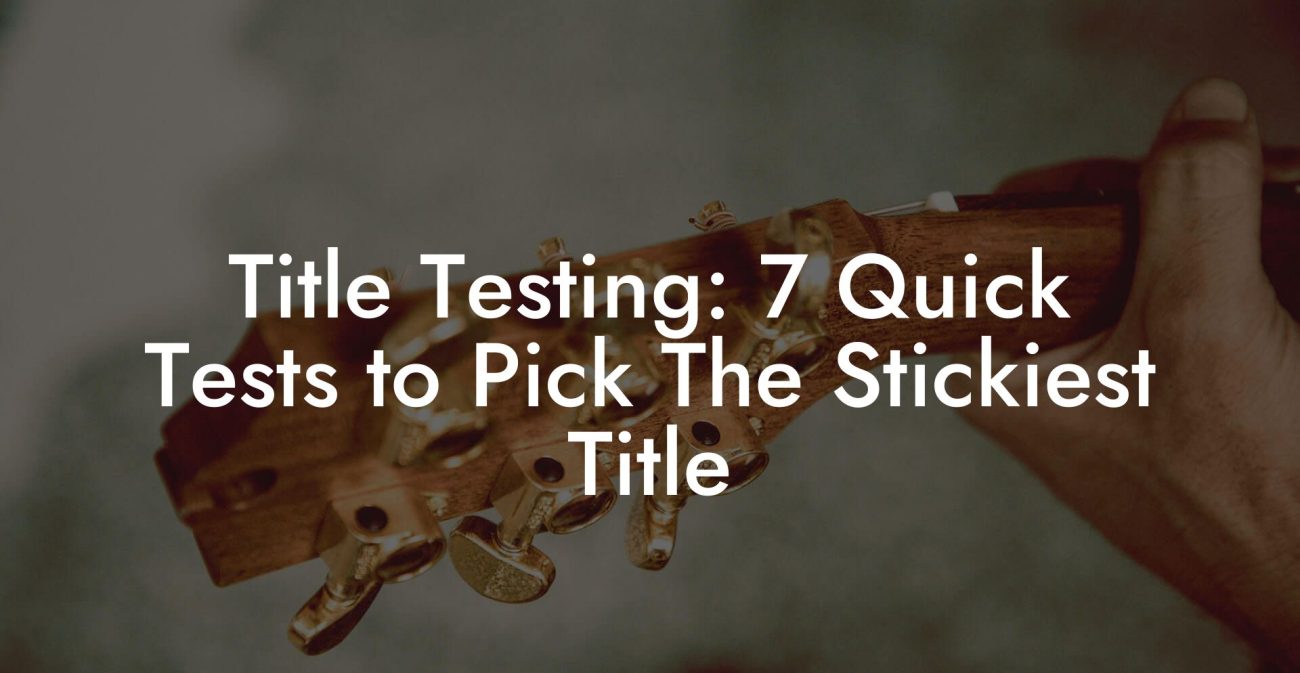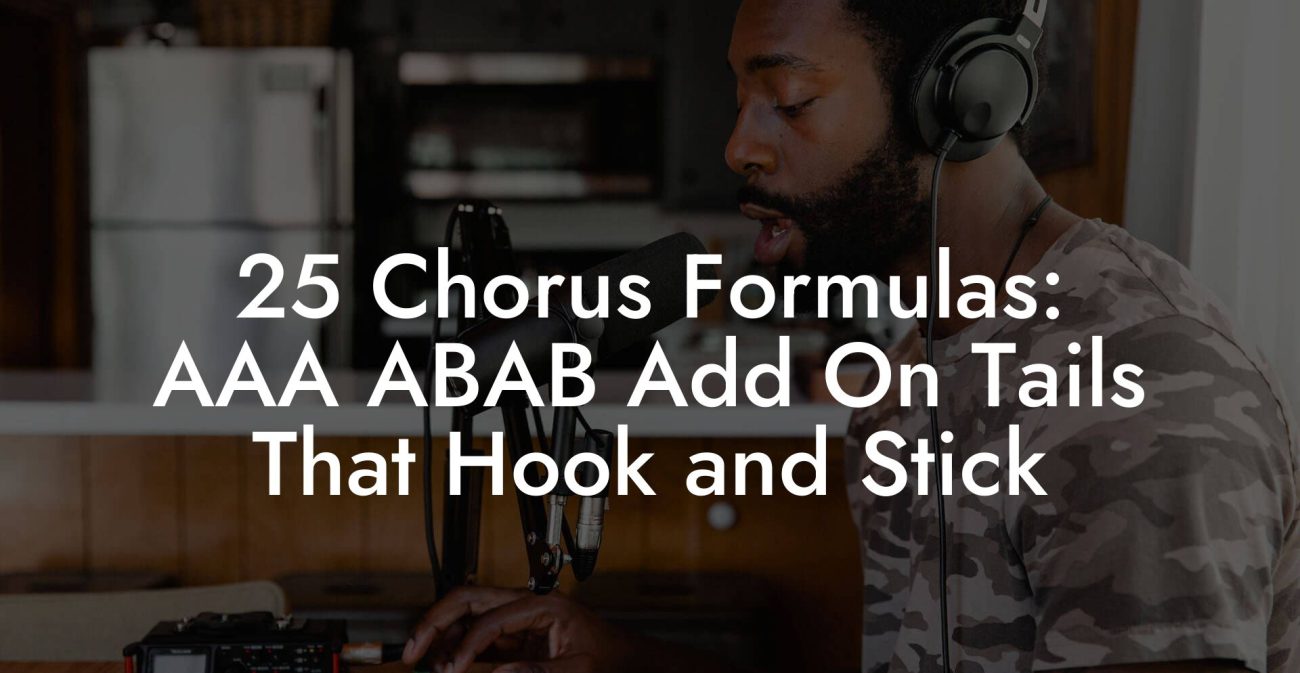Songwriting Advice
Pre Chorus vs Lift: When to Use Which (with Counts)

Quick truth. A pre chorus is a conversation. A lift is the eyebrow raise before you drop the mic. Both tease the chorus. Both come with magical powers and petty weaknesses. Use the right one and your song pulls listeners like a gravity field. Use the wrong one and people reach for their phones to check the group chat.
Quick Interruption: Ever wondered how huge artists end up fighting for their own songs? The answer is in the fine print. Learn the lines that protect you. Own your masters. Keep royalties. Keep playing shows without moving back in with Mom. Find out more →
Quick Links to Useful Sections
- What is a pre chorus and what is a lift
- Pre chorus
- Lift
- Core differences in function
- Counts and timing basics you need to know
- When to use a pre chorus
- Scenario A: Story song reply
- Scenario B: Pop radio format
- When to use a lift
- Lift types and counts
- Use both pre chorus and lift the right way
- Melody and prosody tips for pre chorus and lift
- Lyric strategies
- Production and arrangement tricks you can steal
- Pre chorus production tricks
- Lift production tricks
- Examples from songs you know
- Common mistakes and how to fix them
- Exercises to practice pre chorus and lift
- Exercise one
- Exercise two
- Exercise three
- How to decide in the studio checklist
- Production notes for common tools
- Real life scenarios you will face
- The single songwriter in a bedroom
- The dance producer building a banger
- The indie songwriter who values words
- Advanced: using tension and release curves
- Pros and cons quick list
- Pop culture memory trick
- Pre Chorus and Lift FAQ
This guide gives you the how and the why. You will get simple templates with counts, real life scenarios you can relate to, production tricks you can steal, lyric and melody moves that work, and exercises to practice today. If you write songs you want people to sing to strangers, this is your cheat sheet.
What is a pre chorus and what is a lift
If you do not know these terms yet, you are not alone. Here they are in plain language and one sentence explanations that do not require a music theory degree.
Pre chorus
A pre chorus is a short section between the verse and the chorus that changes energy, lyrical focus, or harmony so the chorus feels like a destination. It often spans one to four bars or one to two phrases and exists to plant the listener on the edge of the chorus.
Real life analogy. You meet someone on a dating app. The verse is your first series of texts. The pre chorus is the voice note that makes them lean in. The chorus is when they say yes to drinks.
Lift
A lift is a micro build that happens immediately before the chorus. It can be one bar, one vocal run, an instrumental riser, a held chord, or a rhythmic drop that increases tension so the chorus hits harder. A lift is compact. It is a theatrical eyebrow lift that cues payoff.
Real life analogy. You are watching a movie. The pre chorus is the scene where the hero rips off their jacket. The lift is the two second drum swell with camera zoom right before the explosion.
Core differences in function
- Length Pre chorus tends to be longer and more lyrical. A lift is short and impact focused.
- Purpose Pre chorus can change harmonic direction and introduce new lyrical information. A lift is mostly about tension release timing and sonic escalation.
- Use case Use a pre chorus when you need narrative or a bigger musical pivot. Use a lift when the chorus needs a dramatic pop or dance style moment immediately after the verse.
Counts and timing basics you need to know
When I say counts I mean how many beats and bars a section occupies. Musicians count beats per bar as one two three four or as one and two and. A bar is a measure. Four beats per bar is common in pop. If you are in a different time signature you can translate the concepts. We will stick to four beats per bar for clarity.
Simple vocabulary
- Beat. The basic pulse you tap your foot to.
- Bar. A group of beats. In common pop music a bar has four beats.
- Count. Saying one two three four to locate where you are inside a bar.
- Phrase. Usually a group of bars that feels like a musical sentence. Often four bars.
Examples in count form
- One bar count: 1 2 3 4
- Two bar lift counts: 1 2 3 4, 1 2 3 4
- Common pre chorus length: two bars or four bars. So counts like 1 2 3 4 x two or 1 2 3 4 x four.
- Common chorus length: eight bars or sixteen bars depending on arrangement.
When to use a pre chorus
Use a pre chorus when you want the chorus to mean more than the hook line sitting on a beat. That sounds fancy. Here is the practical checklist.
- You need the story to step forward. If the verse tells the setup and the chorus is the emotional thesis, the pre chorus is the bridge between them.
- You want a harmonic or modal change into the chorus. A pre chorus can switch chords so the chorus feels brighter or darker.
- You want to create contrast in melody. Keep verse melody lower and more speech like. Use a pre chorus to climb in range before the chorus.
- You need space to tease the chorus title without saying it. A pre chorus can audition the title as a lyrical preview.
- You have room in the song to breathe. If your song is already racing you may not want a long pre chorus.
Practical examples and counts
Scenario A: Story song reply
Verse eight bars. Pre chorus four bars. Chorus eight bars.
Counts example
Verse counts: 1 2 3 4 repeated x eight bars.
Pre chorus counts: 1 2 3 4 repeated x four bars. In bar three of pre chorus add a vocal climb to build tension.
Why this works. The pre chorus gives you space to add a new plot point before you drop the emotional line in the chorus.
Scenario B: Pop radio format
Verse eight bars. Pre chorus two bars. Chorus eight bars.
Counts example
Pre chorus counts: 1 2 3 4, 1 2 3 4. Use a rhythmic switch and narrower words. Save the vowel for the chorus.
Why this works. The shorter pre chorus keeps momentum and still creates a feeling of escalation into the chorus.
When to use a lift
A lift is the blunt instrument of excitement. Use it when you need a second by second cue that the chorus is coming. It is especially powerful in electronic dance music, pop tracks that want a snap, and any moment you want people to raise their phones to record.
- Use a lift to highlight a beat drop. The lift is the build.
- Use a lift when the chorus is largely rhythmic and short. The lift gives the ear something to crave for one or two bars.
- Use a lift when you want the chorus to feel like impact rather than resolution.
- Use a lift if your chorus hook is short and you want a micro drama before it.
Lift types and counts
- One bar vocal lift. Counts: 1 2 3 4. A single held syllable or a run that stretches across the bar.
- Two bar instrumental lift. Counts: 1 2 3 4, 1 2 3 4. Could be a riser, reversed cymbal, or increasing filter sweep.
- Half bar stutter lift. Counts: 1 and 2 and. Use rhythmic chopping to create urgency on the last half bar before the chorus.
Real life scenario. You are at a packed show. The verse is intimate. The lift is the tiny drum fill that makes the crowd stand. When the chorus hits people scream and the clip goes viral. That is lift economy at work.
Use both pre chorus and lift the right way
You can use both. Many hit songs do. The pre chorus leads the narrative. The lift handles the immediate sonic tension. But be careful. Adding both increases length. That can be great if the track needs drama. It can be a problem if the song loses momentum.
Common template that uses both
- Verse eight bars
- Pre chorus four bars
- Lift two bars
- Chorus eight bars
Count example walked through
Verse: 1 2 3 4 repeated x eight bars to establish groove and lyrics.
Pre chorus: 1 2 3 4 repeated x four bars. Use a melody that climbs and a chord that hints at the chorus tonic.
Lift: 1 2 3 4, 1 2 3 4 x two bars. Layer a riser, tighten the percussion, hold the last vocal syllable across the first lift bar and chop it on the second for effect.
Chorus: landing on beat one after the lift for maximal impact.
Melody and prosody tips for pre chorus and lift
Prosody is the match between natural word stress and musical stress. When in doubt, speak the line at normal speed and mark the stressed syllables. Those stressed syllables should land on stronger beats. If they do not, your listener will feel a mismatch even if they cannot name it.
- Pre chorus melody tip. Use stepwise motion that climbs. Keep words that feel conversational. Save big leaps for the chorus.
- Lift melody tip. Use either a held vowel or a short ascending vocal run. The lift is not a place for dense lyrics. Keep it mostly sonic.
- Title placement. If the title is the chorus hook put it on beat one after the lift. If you want the title to feel earned place it near the end of the pre chorus then use the lift to agitate the vowel.
Lyric strategies
Pre chorus is for meaning. Lift is for feeling.
- Pre chorus lyric move. Add a single piece of new information that reframes the verse. If your verse is about walking home alone add a line in the pre chorus that reveals why you are walking. That gives the chorus sharper stakes.
- Lift lyric move. Use short repeated sounds or a single evocative word. The idea is not to explain. The idea is to amplify emotion. Think of the lift as a scream into a microphone that is melismatic and text light.
Production and arrangement tricks you can steal
Production is the part where your song gets its personality. Here are high return moves for pre chorus and lift.
Pre chorus production tricks
- Subtractive arrangement. Remove low bass or full drums for the first bar. Let the vocal float. Then add a bass hit on bar two to escalate.
- Harmonic shift. Introduce a new chord or an inversion that leads into the chorus tonic. This makes the chorus feel like a release.
- Backing vocal beds. Add a sustained pad behind the vocal to make the pre chorus sound wider without adding busy percussion.
Lift production tricks
- Riser and noise. White noise risers, reversed cymbals, pitch rises, and filtered sweeps are classic tools that translate to instant lift energy.
- Percussion chop. Shorten hi hat patterns and add a snare roll that accelerates into the chorus count.
- Vocal stutter. Chop a held vowel with a gate or manual edit so it turns into a rhythmic instrument on the last bar before the chorus.
- Silence as a tool. A one beat hold of silence before the chorus can be a lift. The brain leans in during silence. Use it like seasoning.
Production scenario. You are producing on a laptop late at night. The chorus needs more hit on radios. Try a two bar lift where the first bar is a filtered synth sweep and the second bar is a vocal hold with a snare fill. The chorus arriving on the downbeat will feel larger immediately.
Examples from songs you know
We will call out structure without gatekeeping. These examples are for learning not for stealing line for line.
- Song example one. The verse sets a story. Then a two bar pre chorus uses a new chord and a rising melody. The chorus drops bigger and the title hits on beat one. Classic pop arrangement.
- Song example two. A four bar verse leads straight into a one bar lift that is mostly percussion and a held vocal. The chorus hits like a wave. This is common in modern dance influenced pop.
Common mistakes and how to fix them
- Pre chorus that repeats the verse. Fix by adding a new image or a harmonic change. The pre chorus must move the story forward.
- Lift that is cluttered with words. Fix by removing lyrical content. Make the lift mostly sonic and let the chorus carry meaning.
- Too many layers in the pre chorus. Fix by choosing one new element and removing competing parts to keep the moment clear.
- Lift that arrives late. Fix by tightening counts. A lift must finish right before the chorus downbeat. Count it out loud and practice the transition.
Exercises to practice pre chorus and lift
Do these in a DAW or with a metronome. Time box each exercise to ten minutes so you avoid over editing and over thinking. Speed gives truth.
Exercise one
Set tempo. Make a two chord loop for thirty seconds. Write a verse melody for eight bars. Then write three versions of a pre chorus in two different lengths. Version one is two bars. Version two is four bars. Version three is a lift of two bars only. Record each and choose which leads into your chorus better.
Exercise two
Lift only. Create an empty bar with no harmonic change. On the last two beats of the bar hold a vowel. Automate a filter sweep and a reverb build across that bar. Drop a snare fill at the last beat and hit the chorus on downbeat one. Repeat with half bar lifts and one bar lifts to learn impact timing.
Exercise three
Story and tease. Write a verse that ends with a question. Use a pre chorus to answer the question in part. Use a lift after the pre chorus to amplify the emotional word that you keep repeating in the chorus. This teaches lyrical economy and melodic payoff.
How to decide in the studio checklist
- Is the chorus a thesis or an impact moment? If thesis consider pre chorus. If impact consider lift.
- Do I need more lyrical space? If yes then use a pre chorus.
- Does the chorus need micro drama immediately prior? If yes then use a lift.
- Do I have room in song length? If not prefer a short lift instead of a long pre chorus.
- Will the audience be in a club or in their headphones? Clubs love lifts. Headphone ears can handle a pre chorus that adds narrative nuance.
Production notes for common tools
If you are working in a DAW which stands for digital audio workstation like Ableton Live, Logic Pro, or FL Studio you will use certain tools to craft lifts and pre chorus transitions. VST stands for Virtual Studio Technology. VSTs are plugins that make synths, risers, and effects. Here are quick plugin tips.
- Risers and sweeps. Use noise generators and pitch automation. Layer a white noise riser with a pitch bent synth to make a classic lift. Time the automation to the counts of the lift bars.
- Reverse cymbal. Reverse a cymbal sample and place it so that its attack points at the chorus downbeat. The reverse creates a natural lift.
- Vocal processing. For a pre chorus try light doubling and a plate reverb to keep clarity. For a lift try saturated delays and a short gated reverb to create a sense of space without blurring the arrival.
- Automation lanes. Automate low cut filters on the bass during the pre chorus to create a sense of the foundation being pulled out. Then sweep the filter back into the chorus.
Real life scenarios you will face
The single songwriter in a bedroom
You have a verse and a chorus. You are not a producer. Start with a compact two bar pre chorus that is sung. Keep the instrumentation minimal. Use the pre chorus to explain why the chorus matters. You can add a lift later once the topline is locked.
The dance producer building a banger
Your track will be heard in speakers that make people's chests rattle. Use a small pre chorus for any lyrical need. Then use a heavy two bar lift with both synth riser and percussion fill that increases tempo energy before the chorus drop.
The indie songwriter who values words
Use a longer pre chorus that adds narrative detail. Keep the lift subtle. Perhaps use a one beat rest or a whispered line to create anticipation. The emotional clarity is the hero. Let the lift be small so the words land.
Advanced: using tension and release curves
Consider the song as a curve of tension. The verse builds slowly. The pre chorus should increase the curve more gradually. The lift is the spike that sends the curve into the chorus peak. If the pre chorus already spikes too much you may not need a lift. Visualize the tension curve when arranging and you will avoid stacking too many spikes that make the chorus lose meaning.
Pros and cons quick list
- Pre chorus pro. Adds narrative and harmonic context. Con. Adds length and can feel slow.
- Lift pro. Immediate excitement and radio friendly drops. Con. Can feel gimmicky if overused.
- Both pro. Maximum payoff if used tastefully. Con. Risk of diluting momentum and confusing the listener if not executed cleanly.
Pop culture memory trick
Remember this mental shorthand. Pre chorus equals conversation. Lift equals eyebrow. When you write ask which you need. If the listener should understand why the hook matters choose conversation. If the listener should feel the hook hit choose eyebrow. If the hook needs both use a short pre chorus and a tiny lift. This phrase will save you hours of indecision on take four of a vocal session.
Pre Chorus and Lift FAQ
What is the typical bar count for a pre chorus
Typical pre chorus length is two bars or four bars depending on song style. Four bars gives space for melodic movement and lyrical change. Two bars keeps momentum and works well in radio friendly formats. Always count with your arrangement and test both lengths.
How long should a lift be in bars
Lifts are usually one bar or two bars. They can be half a bar if you want a quick rhythmic tease. The key is that a lift should end right before the chorus downbeat for maximal impact.
Can a chorus follow a verse directly without either
Yes. Many songs move straight from verse to chorus for immediacy. Use this when the chorus is strong and you need the song to be lean or when you want to maintain raw momentum.
Should the title always be in the chorus
Not always. The title often lives in the chorus because that aids memorability. But titles can appear in the pre chorus or verse as a payoff strategy. If the title is rhetorical place it where it makes the most emotional impact.
Is a lift the same as a build
They are related but not identical. A lift is a micro build placed immediately before the chorus. A build can be longer and span a pre chorus and multiple sections. The lift is a specific short technique inside the broader family of builds.
How do I count a lift live with a band
Count out loud. Say one two three four for each bar. If your lift is two bars count both bars together. Use a click if needed when rehearsing. Agree with the band where the lift ends and who plays the cue into the chorus to avoid timing errors.
Can lifts be instrumental only
Yes. Instrumental lifts are common and highly effective. A short instrumental rise with percussion and effects can cue a chorus without any vocal change.
What are good starter ideas for a lift when you have writer block
Try one of these. Hold a vowel on the last beat of the pre chorus and push reverb. Add a two bar snare roll that accelerates. Layer a white noise sweep. Mute the bass for one bar then drop it on the chorus downbeat. Silence can also be used as a lift.




